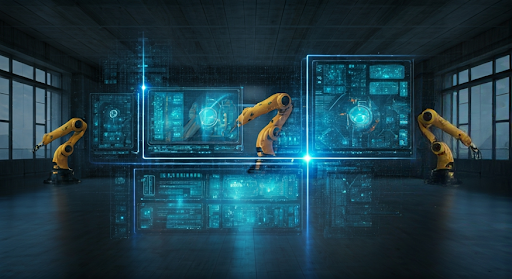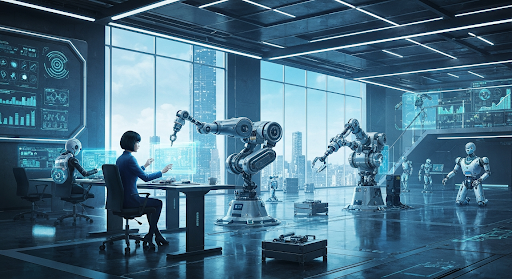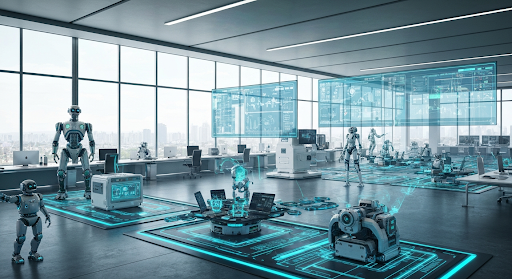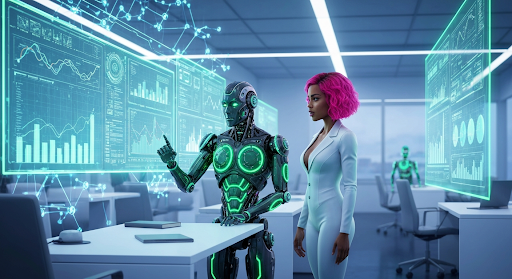The Future of Work: Embracing Robots Automation Technology
Key Highlights
• Automation technology and robotics are revolutionizing how businesses approach repetitive tasks, driving efficiency in both production environments and digital workflows.
• Robotic process automation (RPA) and intelligent automation are enabling companies to streamline office processes, reduce human error, and maximize productivity.
• The use of robots extends from industrial automation on production lines to complex cognitive automation in sectors like healthcare and logistics.
• Major advancements in machine learning and artificial intelligence now allow robots to handle more complex use cases.
• U.S. industries are rapidly adopting automation tools for business process automation, resulting in tangible benefits and new workplace challenges.
Introduction
All over the United States, robots and automation technology are making big changes to how people work. With artificial intelligence, companies now have machines to do jobs that people used to do. You can see robots on factory lines welding metal. There are also software bots handling the paperwork, and smart systems that can make quick choices. This is not only for better speed. The goal is to find new ways to get the work done, make jobs more accurate, and let people spend more time on tasks that need their creative ideas and human skills.
Understanding Robotics and Automation in the Modern Workplace

In today’s business world, robotics and automation help change how things are done. Robotics takes ideas from engineering and computer science to build machines. These machines can do many things, like help with assembly lines or work in customer service. Automation uses technology, such as machine learning, to do repetitive tasks. These tasks get done without people needing to step in each time.
These tools are now a big part of how things happen in places where goods are made. There are both physical robots and software robots at work. They boost how much you can get done, make things safer, and let people use their skills for new ideas. Let’s look at the ways each plays a part and what jobs they do.
Key Differences Between Robotics and Automation
Understanding the difference between robotics and automation is important when your business wants to choose the right technology. Automation is when you use technology, like machines or software, to do tasks by itself. This means people do not have to step in that much or at all. For example, you can make the lights in a building turn on and off by themselves, or get special software to handle work in a factory.
Robotics is when you design, build, and use programmable machines that can do tasks on their own or with just a little help from people. At first, a person may need to set up or program the robot, but after that it uses its sensors and controls to work mostly by itself. These machines, often called robots, are a type of automation technology.
In the workplace, you will see robotics as a part of automation because both make work easier by doing things people used to do. Still, you can have automation without robots, like when software helps get invoices done. But robotics always has a physical or virtual machine involved that you can touch or see in action. As Dr. Alex Owen-Hill says, “Robotics is not the only type of automation, but a robot is an automation technology.” Both robotics and automation get used together a lot. They give people custom ways to reduce human intervention and solve tough jobs.
Common Industry Applications in the United States
American industries now use a lot of robotics and process automation. They have seen big improvements in how much work gets done and how good their products are. In the world of manufacturing, industrial robots put together products, weld parts, and check for problems. They do this faster and more accurately than people can. In offices, business process automation is on the rise, and software robots help with digital paperwork and data entry. This saves time for people and makes things run better.
You’ll see the use of robots and automation in these areas:
- Production lines: Robots are used for assembly, painting, and packaging jobs.
- Logistics and warehouses: Automated systems sort and move items around which makes things faster and easier.
- Healthcare: Robots help doctors with surgeries and do routine tasks like handing out medicine.
- Retail: Automation tools help with inventory management and make the customer experience better.
Thanks to automation software and business process automation, U.S. companies are staying in the game globally. They cut down on costs and improve business process steps. This helps them grow and stay strong over time.
The Evolution of Robots and Automation Technology

Over time, automation technology has moved from basic machines to smart systems that can learn and change over time. At first, industrial automation changed the way factories worked. This started with programmable machines and robot automation on the production line.
Now, advanced technologies such as artificial intelligence and computer vision are driving a new stage of industrial automation. With these innovations, companies can react quickly and make smart choices in the production environment. This helps businesses stay strong and flexible as the market keeps changing.
Milestones in Industrial Automation
Industrial automation has experienced dramatic milestones that have redefined the modern workplace. The earliest systems relied on fixed automation, where machines executed repetitive tasks in a single location. Over time, programmable machines emerged, allowing for flexible production and adaptation to new products.
Robot automation now powers entire production lines, integrating sensors, data analytics, and AI to optimize every process. As described by experts, intelligent automation is the current frontier—enabling autonomous decision-making and real-time error correction.
Here’s a breakdown of key industrial automation milestones:
| Era/Technology | Description |
|---|---|
| Fixed Automation | Rigid systems for repetitive tasks(e.g., early automotive assembly lines) |
| Programmable Automation | Machine reprogrammed for different products/processes |
| Flexible Automation | Rapid adaptation to changing market demands |
| Intelligent Automation | Uses AI, machine learning, and analytics for real-time decision-making |
This evolution continues, shaping industries with smarter, more integrated systems.
Recent Advancements and Emerging Trends
In the past few years, there has been a big jump in automation technology. This is mostly because of artificial intelligence, machine learning, and computer vision. These new tools help with cognitive automation. Thanks to them, software and real robots can now learn from data. They can also change what they do to take on new work. All this can happen with little human intervention.
Today, we see some new trends:
- Collaborative robots (cobots) are built to work safely next to humans. This makes the workplace more flexible.
- Wider adoption across sectors means more places use automation—like healthcare and farming. This pushes new ideas beyond just regular factories.
- Integration of cognitive automation lets robots use AI to make choices and do better, even when things change or seem random.
With these changes, robots and automation technology are showing us new ways to work. They help businesses in the U.S. to get smarter, safer, and better at what they do, even as things keep changing.
Robotic Process Automation (RPA) in Business
Bringing robotic process automation into a business changes how things work, especially in financial services. When companies use RPA bots, they can handle repetitive tasks faster. This helps lower human error and makes work more accurate. These software solutions let people do less, because the bots do the regular jobs. At the same time, they help out with complex tasks through cognitive automation and natural language processing. In the end, the positive effect of process automation is clear. It makes the internal processes better, brings a good customer experience, and supports digital transformation.
How RPA Works to Streamline Operations
Robotic process automation changes the way businesses do routine tasks. It lets rpa bots take care of digital jobs that people used to spend hours on. With rpa software, these bots use scripts to copy how a person would use apps. This means they can log in, move data, or handle forms.
Key ways RPA makes things work better:
- Seamless integration: Rpa bots work with all kinds of old and new apps. They move transactions and set up workflows without changing the systems you already have.
- Rule-based automation: The bots follow clear rules. This helps make sure work like financial data entry or following rules and laws is always right.
- Rapid deployment: These tools have easy, low-code setups. Even staff who are not into tech can build and control process automation. This helps more people start using it fast.
When you let rpa bots handle repeated computer tasks, there is less human error. Things move faster, and people get to spend time on big, creative jobs. This is good for saving money and getting more done.
Popular RPA Software Platforms and Tools
There are a few RPA software solutions that are leading the way in business process automation. Each of these software solutions gives people the automation technology needed to set up software robots. The robots work in many business processes and link up with other business systems.
Some notable rpa tools include:
- IBM Robotic Process Automation: This rpa software helps automate back-office work. The software robots be able to copy the human actions you or others do at work.
- UiPath and Automation Anywhere: Many people like these tools because they have easy-to-use, low-code setups. They work with a wide range of business process applications.
- Blue Prism: This software is known for safe and scalable automation. People at large companies often choose it when they need to handle a lot of business processes.
- Microsoft Power Automate: This tool connects rpa software features right inside the Microsoft suite. This makes process automation easy to get for lots of users.
With these rpa tools and software solutions, businesses can use intelligent automation by bringing together robotic process automation, AI, and process mining. This helps them manage both simple and more complex business process challenges in a faster, better way.
Types of Robots Shaping Workplace Automation
Workplace automation is no longer just for the factory floor. It is growing because of many types of robots and new software robotics. You will see more programmable machines in manufacturing now. There are collaborative robots that help workers. You will also find special bots that make office tasks quicker and easier.
The use of robots is spreading in every direction. There are now more robots working on the production line and in other places too. Some are precise industrial robotics, and others work as service robots in logistics and healthcare. Let’s look at how industrial robots and collaborative robots are different. We will also talk about how they help in logistics and service jobs.
Industrial Robots vs. Collaborative Robots (Cobots)
Industrial robots are made to handle high-volume work. They do repetitive tasks with great care and speed. Their main role in automation technology is to take over jobs that are usually done by people. This helps workflows run better and need less human intervention.
On the other hand, collaborative robots, also known as cobots, work with people. They boost productivity by using intelligent automation. Cobots fit easily into the processes you already use. They use machine learning and computer vision to change and work with different production tasks. The teamwork between humans and cobots shows how robotics is changing business now.
Robots Used in Warehouses, Logistics, and Service Industries
Automation technology is changing the way warehouses, logistics, and service industries work. This happens because of different robots made for each job. The machines help people do things faster, better, and more safely where there are many repetitive tasks.
Some common robots are:
- Autonomous mobile robots (AMRs): These move around the aisles in warehouses, picking up and carrying goods. They use computer vision to help guide them where they need to go.
- Sorting and packing robots: They sort items and pack them using robotic arms and special sensors. This helps get the job done faster, with fewer mistakes, and at a lower cost.
- Service robots: These robots help with customers. You may see a robot greet people in a hospital, or a robot bring things to your room in a hotel.
With new computer vision and cognitive automation, these robots can deal with changes in where things are or what jobs are needed. So, logistics and service work gets more responsive and reliable for everyone.
Benefits and Challenges of Integrating Robots and Automation
Bringing automation and robots to the workplace can make a big difference. The main benefits are more work done, better accuracy, and faster results. Machines can do routine jobs and handle complex tasks much quicker than before.
But putting these technologies into current business systems and human resources setups is not always easy. Companies need to deal with how people will adjust, what technology can and cannot do, and the push for digital transformation all the time. This is where automation can be great, but there can also be some problems to work out.
Efficiency Gains and Enhanced Productivity
Robots and automation help workplaces be more efficient and get more done. When these systems take over routine tasks, they cut down on human error. This means the work can go at a greater speed and does not stop.
On a production line, for example, robots can work all day and night. This boosts output and helps keep quality the same every time. Using automation software, companies can do things like data entry or compliance checks faster. This lets human workers have more time to think through bigger decisions.
The Harvard Business Review talks about the positive effect of automation. They say companies who use robots and automation software see faster results. They also get greater accuracy and give their people less repetitive work. This improves employee morale. When you have the right automation strategy, your business can do more with less effort. This helps drive lasting growth.
Workforce Impacts and Implementation Obstacles
Bringing the use of automation and robots into your business can change how people work and what roles they have. This shift may mean you do not need as many people for simple, repeating tasks. Even so, the change also opens up chances for people to help manage, program, or fix these new tools. People will find new ways to work with digital transformation.
Common challenges include:
- Training and adaptation: Workers must learn some new skills if they want to do well as digital transformation happens.
- Integrating with legacy systems: Many groups find it hard to connect new rpa implementations with old technology or legacy systems.
- Scaling automation: It’s not easy to move from a small trial to a bigger roll-out. You have to make good plans and give the right people and money for the job.
Even with all this, groups that put time and care into building up their human resources and teaching people how things are going to change will be more likely to get the most from the power of automation in the workplace.
Real-World Examples of Robots and Automation Improving Business
Across many types of industries, automation and robots help make business process automation better. In manufacturing, these systems help cut down on mistakes and let people speed up production. In service industries, automation technology makes daily jobs easier and helps increase customer satisfaction.
From production lines to hospital wards and logistic hubs, the use of robots brings faster and more accurate results. This shows the real power of intelligent automation in business process automation and other real-world use cases. Let’s look at some of the best success stories from different sectors.
Automation Success Stories in Manufacturing
Manufacturers have been some of the first to use automation software and robot technology. In the automotive industry, you can see robotic arms do welding and painting. This helps products be made faster and the work is more exact than when people do it by hand. Big electronics brands use robots to put things together and check the work. This leads to fewer mistakes and less waste.
Robotic process automation also helps with back-office jobs. Tasks like inventory management and getting supplies run smoother. The Harvard Business Review says that automation in manufacturing brings higher output, fewer mistakes, and helps keep workers safe by letting robots handle dangerous work.
Manufacturers who use the newest production line technology see a positive effect. They get more work done, save money, and their workers are happier. These gains from process automation show how valuable it is for everyone in the sector.
Case Studies from Retail, Healthcare, and Logistics
Service businesses are now using automation technology to make customer experience better and to improve the way they work. In retail, many companies now turn to process mining and RPA tools. They use these tools to help manage inventory, stop fraud, and speed up order shipping.
- Healthcare networks: Hospitals are putting robots to work. These robots help with giving out medicine and handling patient data. This makes things more accurate and helps the hospital follow the rules. It also lets staff spend more time with patients.
- Logistics providers: Warehouses now rely on sorting robots and self-driving vehicles. These machines take care of repetitive tasks. With automation technology, they can move products faster and make fewer mistakes.
Retailers can also use real-time analytics, which is a form of RPA, to plan promotions and run supply chains better. These stories show automation is more than just a manufacturing idea. It is now changing the way all kinds of businesses work.
Strategies for Businesses Adopting Robots and Automation
To keep up with others, businesses need good plans to bring automation software into their work. Digital transformation is not only about getting new robots or software. It is about making clear plans, checking the business process often, and helping the people who work there to grow.
It is also important to have teams where human intelligence works well with technology skills. This mix helps the company find the right way for automation to last. Next, we will talk about what they need for a strong automation journey.
Key Factors for a Successful Implementation Plan
Effective automation begins with a clear plan. Businesses need to pick the right tasks for process automation. They should set goals and find the best mix of software components and robotics that fit what they need.
Key factors are:
- Process assessment: Take a close look at how things work now to find spots where process automation can help the most.
- Technology selection: Choose intelligent process automation tools that fit business needs. These tools have to work with the systems that are already in use.
- Change management: Make sure to talk to employees and give them training, so they know their new roles and can help with the automation projects.
Experts say that knowing what you want, using the right technology, and keeping people involved will make for better automation. This sets up the team to keep making things better over time.
Building a Forward-Thinking Workforce
Adopting robots and automation technology is a way to invest in your workforce. People need the right skills and the confidence to work with these new systems. They also need to be able to manage new ways of doing things and use the potential of digital transformation.
- Upskilling and reskilling: Offer training that helps people use human intelligence in their roles, new technical skills, and ways to handle automation tools.
- Empowering human resources: Build a workplace culture where people see automation technology as a chance to grow, and not as something that takes away their job security.
Forward-thinking companies see that their people are key when it comes to successful automation. When an organization supports adaptability and learning all the time, their teams stay strong and involved, even as technology moves ahead.
Conclusion
The future of work will be very connected to robotics and automation technology. Businesses want to get more done and improve how they work, so it is important to understand these new tools. When you bring in robots, you can get a lot more work done quickly, but there will be some challenges along the way. Companies need to be smart about how they add new technology and should help their teams get ready for these changes. There is a lot of room for new ideas and better ways to work, so now is a good time to act. If you want to see how automation technology and robotics can help your company, contact us now for a free consultation.
Frequently Asked Questions
What is the impact of automation on job opportunities?
Automation changes job opportunities in many ways. It takes away some repetitive tasks that people used to do. At the same time, it makes more jobs that focus on digital transformation and taking care of automated systems. Some jobs that people have had for a long time might start to go away. But there will be new roles in technology and the ways the workforce is managed as companies move to new ways of working.
How can small businesses adopt robotics technology?
Small businesses can begin with affordable automation software, RPA tools, and cloud-based software solutions tailored to what they need. Many of these platforms give low-code choices. This helps you put robotics technology in place without the need for big IT teams or spending a lot of money up front.
Are there ethical concerns with increasing workplace automation?
Yes, there are some ethical concerns. Workplace automation can affect job security. It can lower the need for human intervention. This can also change the usual ways people work in human resources and with artificial intelligence. There has to be a balance between getting work done fast and being fair. It is important to be open and responsible, so all workers get fair results.



